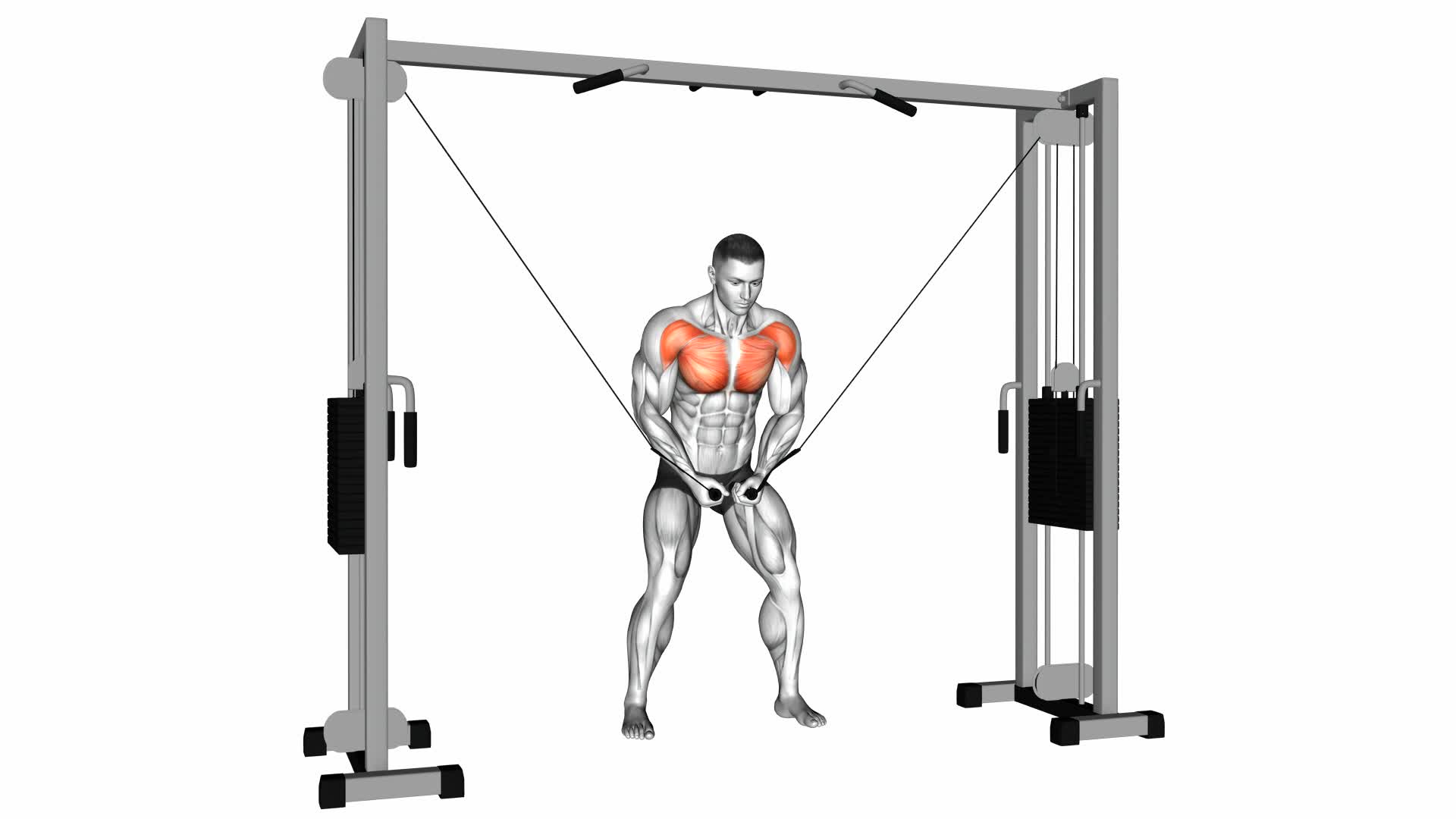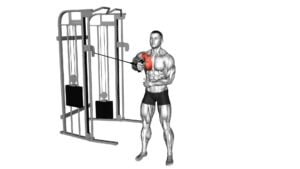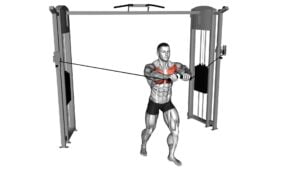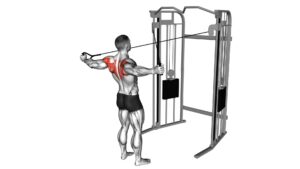Cable Standing Fly – Video Exercise Guide & Tips

Are you looking to strengthen and tone your chest muscles? Look no further than the cable standing fly!
Watch This Exercise Video
In this video exercise guide, we'll show you the proper form and technique for this effective exercise. With variations and modifications to suit your fitness level, you can avoid common mistakes and maximize your results.
Get ready to feel the burn and see those chest muscles sculpted like never before. Let's dive in and get started!
Key Takeaways
- Cable Standing Fly is effective for activating the chest and shoulder muscles.
- Proper form and technique are crucial for maximizing the benefits of the exercise.
- Adjusting the weight and resistance levels allows for progressive overload and optimal results.
- Consistency and listening to the body are important for preventing injury and achieving desired outcomes.
Benefits of the Cable Standing Fly
When performing the Cable Standing Fly, you'll experience a range of benefits for your chest and shoulder muscles. This exercise is highly effective for muscle activation in these areas, helping you to strengthen and tone your upper body. The Cable Standing Fly specifically targets the pectoralis major, which is the large muscle that makes up the majority of your chest. By engaging this muscle, you can improve its strength and size, resulting in a more defined and sculpted chest. Additionally, the Cable Standing Fly also activates the anterior deltoids, which are the muscles located at the front of your shoulders. This helps to enhance the overall appearance and strength of your shoulders.
One of the major advantages of the Cable Standing Fly is its workout efficiency. Unlike traditional dumbbell fly exercises, the cable machine provides constant tension throughout the entire range of motion. This means that your muscles are continuously engaged, maximizing the effectiveness of each repetition. Additionally, the cable machine allows for adjustable resistance, allowing you to easily increase or decrease the weight as needed. This allows for progressive overload, which is essential for muscle growth and strength development.
Proper Form and Technique
To perform the Cable Standing Fly with proper form and technique, position yourself in front of the cable machine with a sturdy stance. Start by setting the cables at chest height and grasping the handles with an overhand grip. Stand with your feet shoulder-width apart and maintain a slight bend in your knees. Engage your core and keep your back straight throughout the exercise.
One common mistake to avoid is using too much weight. It's important to choose a weight that challenges you, but allows you to maintain proper form. Using excessive weight can lead to improper technique and increase the risk of injury.
Another common mistake is rushing through the exercise. To maximize results, focus on slow and controlled movements. Keep your arms slightly bent and maintain a slight bend in your elbows throughout the exercise. This will ensure that you engage your chest muscles and minimize strain on your shoulders.
To further maximize results, squeeze your chest muscles at the end of each rep. This will increase the intensity of the exercise and promote muscle growth. Remember to breathe throughout the movement, exhaling as you bring your hands together and inhaling as you return to the starting position.
Equipment and Setup
To ensure optimal effectiveness of the Cable Standing Fly exercise, it's important to consider two key points: the cable height and the anchor selection.
Adjust the cable height to a level that allows for a full range of motion without straining your muscles.
Additionally, choose the appropriate anchor, such as a low pulley or cable column, based on your comfort and stability during the exercise.
Optimal Cable Height
To achieve optimal cable height for the cable standing fly exercise, you should adjust the equipment and setup accordingly. Here are some key points to consider:
- Proper Cable Height: Set the cable pulleys at a height that allows your arms to be slightly higher than shoulder level when fully extended. This ensures proper range of motion and targets the chest muscles effectively.
- Cable Standing Fly Technique: Stand with your feet shoulder-width apart, facing the cable machine. Grasp the handles with an overhand grip and extend your arms away from your body. Keep a slight bend in your elbows and maintain a strong, stable posture throughout the exercise.
- Cable Standing Fly Variations: You can vary the cable standing fly exercise by adjusting the angle of your arms or using different hand positions. Experiment with different variations to target different areas of your chest muscles.
Proper Anchor Selection
Choose the appropriate anchor for your cable standing fly exercise to ensure proper equipment and setup. Anchor placement is crucial in this exercise as it determines the direction of resistance and the angle of muscle activation.
Look for a sturdy and secure anchor point that can withstand the tension from the cables. It should be positioned at a height that allows for a comfortable range of motion and proper alignment of your body.
Make sure the anchor is located directly in front of you, at chest level or slightly higher. This will ensure that you can maintain proper form and effectively target your chest muscles.
Now that you know how to select the right anchor, let's move on to exploring variations and modifications of the cable standing fly exercise.
Variations and Modifications
Now, let's explore some variations and modifications you can make to the cable standing fly exercise.
One option is to try different grip options, such as using an overhand grip or an underhand grip, to target different muscles in your chest and arms.
Additionally, you can adjust the resistance levels on the cable machine to make the exercise more challenging or easier based on your fitness level and goals.
Different Grip Options
Explore various grip options for the cable standing fly exercise to target different muscles and add variety to your workout routine. By changing your grip, you can effectively engage different muscle groups and improve your overall grip strength.
Here are three grip variations you can try:
- Overhand Grip: This is the standard grip where your palms are facing down. It primarily targets your chest and shoulders, helping to build upper body strength.
- Underhand Grip: This grip involves turning your palms up. It shifts the focus to your biceps and forearms, providing a great opportunity to work on your grip strength.
- Neutral Grip: In this grip, your palms face each other. It targets your triceps and provides a different angle of activation for your chest and shoulders.
To further improve grip strength, you can incorporate alternative exercises such as farmer's walks, deadlifts, and pull-ups into your routine. Experiment with different grips to challenge your muscles and keep your workouts interesting.
Adjusting Resistance Levels
To adjust resistance levels for the cable standing fly exercise, you can increase or decrease the weight on the cable machine. By adding more weight, you increase the tension on your muscles, making the exercise more challenging and engaging more muscle fibers. This can lead to greater muscle activation and strength gains.
On the other hand, decreasing the weight reduces the tension on your muscles, making the exercise easier and allowing you to focus on form and technique. Adjusting tension is essential to ensure that you're challenging your muscles appropriately and avoiding plateaus in your progress.
However, it's important to find the right balance – too much weight can compromise your form and lead to injury, while too little weight may not provide enough stimulus for muscle growth.
Common Mistakes to Avoid
What are some common mistakes you should avoid when performing the Cable Standing Fly exercise? To ensure you get the most out of this exercise and minimize the risk of injury, here are some technique tips you should keep in mind:
- Avoid using excessive weight: Using too much weight can compromise your form and increase the risk of muscle strain or joint injury. Start with a weight that allows you to perform the exercise with proper form and gradually increase as you get stronger.
- Don't round your shoulders: Keep your shoulders pulled back and down throughout the exercise to maintain proper posture. Rolling or rounding your shoulders can put unnecessary strain on your neck and upper back.
- Avoid using momentum: It's important to perform this exercise with control and avoid using momentum to swing the weights. This will ensure that you effectively engage your chest muscles and get the most out of the exercise.
Tips for Maximizing Results
To further enhance your results, incorporate these tips into your Cable Standing Fly routine.
Maximizing gains requires proper technique and form. First, make sure to maintain a slight bend in your elbows throughout the exercise. This will engage your chest muscles more effectively and prevent strain on your joints.
Additionally, focus on squeezing your chest muscles at the peak of the movement, rather than simply going through the motions. This will help you maximize muscle activation and stimulate growth.
It's also important to adjust the weight accordingly. Use a weight that challenges you, but allows you to maintain proper form and complete the desired number of repetitions.
Lastly, consistency is key. Aim to perform the Cable Standing Fly at least twice a week to see optimal results. Remember to listen to your body and take rest days when needed.
Frequently Asked Questions
How Many Sets and Reps Should I Do for the Cable Standing Fly Exercise?
For the cable standing fly exercise, it's important to consider the number of sets and reps that you should do. This will help you achieve the best results.
The number of sets and reps can vary depending on your fitness level and goals. It's generally recommended to start with 3-4 sets of 8-12 reps.
As you become more advanced, you can increase the number of sets and reps. Remember to rest for about 60-90 seconds between sets to allow your muscles to recover.
Can I Use Dumbbells Instead of Cables for the Standing Fly Exercise?
Yes, you can use dumbbells instead of cables for the standing fly exercise. Dumbbell alternatives provide a different type of resistance and can still target your chest muscles effectively.
However, using cables for the standing fly exercise offers some unique benefits. Cables provide constant tension throughout the movement, allowing for a greater range of motion and a more controlled contraction. They also engage your stabilizer muscles, promoting better overall strength and stability.
Is It Necessary to Warm up Before Performing the Cable Standing Fly?
Before getting into the specifics of the Cable Standing Fly exercise, let's address the importance of warming up.
Warming up before any exercise is necessary as it prepares your body for the upcoming physical activity. It increases blood flow to your muscles, improves flexibility, and reduces the risk of injury.
While there are alternatives to the Cable Standing Fly exercise, it's always recommended to warm up before engaging in any form of exercise for optimal results and safety.
Can Beginners Perform the Cable Standing Fly Exercise?
Beginners can definitely perform the cable standing fly exercise. This exercise offers numerous benefits, including targeting the chest muscles and improving upper body strength.
To ensure safety and effectiveness, beginners can start with lighter weights and focus on proper form. It's important to maintain control throughout the movement and avoid using momentum.
As beginners progress, they can gradually increase the weight and intensity of the exercise. Remember to listen to your body and make any necessary modifications to suit your fitness level.
Are There Any Specific Muscles Targeted by the Cable Standing Fly Exercise?
The cable standing fly exercise specifically targets your chest muscles, including the pectoralis major and minor. By incorporating this exercise into your workout routine, you can enjoy several benefits.
It helps to strengthen and build your chest muscles, improve upper body strength, and enhance overall upper body aesthetics. To maximize results, it's important to maintain proper form and technique.
Focus on squeezing your chest muscles at the peak of the movement and controlling the weight throughout the exercise.
Conclusion
In conclusion, the cable standing fly is a highly effective exercise for targeting the chest muscles.
By maintaining proper form and technique, using the right equipment and setup, and avoiding common mistakes, you can maximize the results of this exercise.
Incorporating variations and modifications can also help to challenge your muscles in different ways.
Remember to follow these tips and you'll be on your way to achieving your fitness goals.

Author
Years ago, the spark of my life’s passion ignited in my mind the moment I stepped into the local gym for the first time. The inaugural bead of perspiration, the initial endeavor, the very first surge of endorphins, and a sense of pride that washed over me post-workout marked the beginning of my deep-seated interest in strength sports, fitness, and sports nutrition. This very curiosity blossomed rapidly into a profound fascination, propelling me to earn a Master’s degree in Physical Education from the Academy of Physical Education in Krakow, followed by a Sports Manager diploma from the Jagiellonian University. My journey of growth led me to gain more specialized qualifications, such as being a certified personal trainer with a focus on sports dietetics, a lifeguard, and an instructor for wellness and corrective gymnastics. Theoretical knowledge paired seamlessly with practical experience, reinforcing my belief that the transformation of individuals under my guidance was also a reflection of my personal growth. This belief holds true even today. Each day, I strive to push the boundaries and explore new realms. These realms gently elevate me to greater heights. The unique combination of passion for my field and the continuous quest for growth fuels my drive to break new ground.







